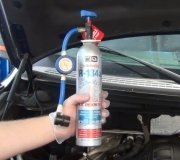I not sure what ring you are referring to, but there are three reasons for putting the system into a vacuum. The first is to verify there are no leaks. If the system cannot be put into a vacuum, or it loses vacuum rather quickly, there is a leak that must be located and repaired. The second is if the vacuum drops off over a longer period of time, say five minutes, there is likely moisture in the system. As the water vaporizes, it expands a real lot, and that results in the vacuum going down. This tells the mechanic to keep pumping the system into a vacuum for perhaps another half hour.
The third reason is for that moisture. Whenever the system is opened for a repair, air gets in along with the humidity in it. Water combines with refrigerant to form an acid that will attack the metal parts, leading to corrosion and a leak. Also, while the receiver/drier is supposed to be able to absorb up to ten droplets of water, if any of that water circulates in the system, it will freeze at the expansion valve or orifice tube where the refrigerant becomes very cold. That ice will block the flow of refrigerant resulting in intermittently no cooling of the incoming air. It typically takes up to fifteen minutes for that ice to melt and start to circulate again. In a vacuum, water boils at 77 degrees F and it can be drawn out. That vacuum also helps get the first refrigerant into the system, then the low-pressure cut-out switch will turn on, or the pressure sensor will indicate there is some pressure in the system, and the compressor will turn on. Once that happens, the low side pressure will be pulled down making it easier to pump in more refrigerant.
With no vacuum, the alternative might include bypassing the low-pressure cut-off switch to get the compressor started, but the air in the system will already have it up to atmospheric pressure. There will be moisture in the system, and when the system is full, it will not be full of one hundred percent refrigerant. The whole idea of air conditioning is a gas becomes very hot when compressed, and that heat is given off at the condenser in front of the radiator. And, once condensed and cooled back to a liquid, it becomes very cold when it turns from a liquid to a gas. That takes place in the evaporator in the dash. R-12 and R-134 change state right in the temperature range we need. Nitrogen and oxygen have to be cooled to a much lower temperature than is practical to turn to a liquid, so they are ineffective as a refrigerant in a car or house. We do not want ineffective gases or liquids in the AC system.
Thursday, June 1st, 2017 AT 1:07 PM



